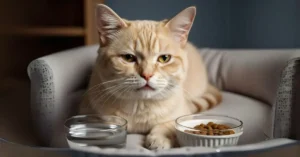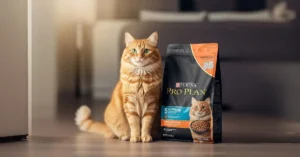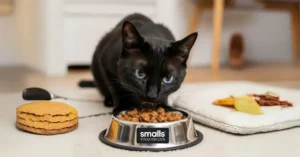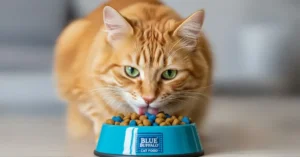Is your cat not drinking like it used to, or maybe they are just drinking too much.
This change is not minor. For cats with kidney diseases, water is not just a daily need. It’s survival. Dehydration worsens their kidneys’ ability to function as they once did.
You don’t need to be a vet to help to fix dehydration in cats. You just need to know how much water cats with kidney diseases should drink, what kind of water they require and what signs to watch out for. This guide will break It all down into simple, clear answers.
Why Is My Cat Drinking So Much Water All of a Sudden?
When a cat suddenly starts to drink more than usual you can tell something is off it may be a sign of early kidney problem. This is not a small change, it can mean the kidneys are no longer working that they are supposed to.
What kidneys do in healthy cats:
- Remove toxins and waste from the blood.
- Maintain the body’s mineral and water balance.
- Help in regulating blood pressure and the production of red blood cells
What changes in chronic kidney disease (CKD):
- The cat pees more because its kidneys can’t hold water.
- Even if the cat drinks a lot, dehydration still occurs.
- The toxins remain in the body, causing the cat to feel drained and ill.
Why water intake is key to managing symptoms:
- Replaces water lost from frequent urination
- Assists in more efficient waste removal
- Lessens the pressure on kidney damage
How Much Water Should Cats with Kidney Disease Drink?
Cats with kidney disease lose more water as compared to healthy cats. Their kidneys cannot hold water like they used to. So even after drinking a lot of water they may still be dehydrated.
Vet guidelines and averages
A lot of Vets recommend 50 to 60 ml of water per kilogram of water on a daily basis.
For example:
- About 225–270 milliliters should be consumed daily by a cat weighing 10 pounds (4.5 kg).
- If the cat consumes dry food with little moisture, this could increase.
- Although they require less water when eating wet food, cats should still drink frequently.
Consider switching to the best cat food for kidney disease, especially wet or canned options designed for hydration, if you are currently feeding your cat affordable dry cat food. These foods are easy on the kidneys and promote hydration.
Behavior cues and Measuring in Milliliters
Every drop doesn’t have to be measured. By simply observing, you can frequently determine whether your cat is drinking enough:
- Do they frequently visit the water bowl but still appear worn out or have dry fur?
- Are they urinating more frequently and in greater quantities?
- Do they paw at their water bowl or hover close to the faucet?
You can learn more from these behavioral cues than just numbers. Your cat may need help staying hydrated, possibly with sub-q fluids for cats with kidney disease, if they drink a lot but still appear weak.
What real cat owners are doing (Reddit experiences)
Are you curious about other people’s opinions regarding hydration? An overview of Reddit threads asking “how much water should cat with kidney disease drink” provides some useful information:
- In order to maintain proper hydration, owners frequently add water to their food.
- Fountains are advised by many veterinarians to promote drinking.
- Some people use high-moisture senior cat food.
Additionally, the Reddit community offers advice such as freezing broth into ice cubes or mixing low-sodium broth with water. Without pressuring your cat, these small actions help increase daily intake.
So, if you’ve asked yourself, how much water should cats with kidney disease drink per day, or how much water should cats with kidney disease drink a day, the simple answer is: enough to replace what’s lost and keep their pee light yellow. This might mean more than 250 ml daily for some cats.
Don’t wait for them to look sick, hydration can keep your cat comfortable and help them avoid fast decline. It can even help your cat live longer.
Best Water for Cats with Kidney Disease: What to Offer and What to Avoid
Cats with kidney diseases require clean water that is the reason why the best water for cats with kidney diseases is usually filtered water. There is no chlorine and metals in filtered water which is good for cats health but this may bother some sensitive cats. Avoid distilled water as it lacks certain needed minerals. Some cats drink more from water fountains than bowl because they prefer running water. Bowls made of ceramic or stainless steel are better to those made of plastic.
To tempt picky cat food eaters and drinkers, you can add a little low-sodium broth. Extra moisture from food helps, especially when you serve cat treats for kidney diseases. Cats who drink better water stay hydrated and prevent kidney damage.
Why Do So Many Cats Get Kidney Disease?
Cat kidney disease is unfortunately widespread, particularly in older cats. The kidneys struggle to filter waste as the cats age. Age isn’t the only factor, though; genetics, specific toxins, and even bad diets can have an impact.
Long-term harm may result from giving cats the worst cat food, such as dry food that is high in salt or artificial ingredients. Some cats have weaker kidneys from birth. Others reside in places where the air or water contains dangerous chemicals. We can help more cats stay healthy for longer by identifying kidney disease warning signs early and providing clean water and better food.
Warning Indications of Cat Kidney Disease
Your cat may start drinking and urinating more frequently. They might eat less, sleep more, or throw up more frequently. Weight loss in cats is a serious indicator of kidney disease, particularly if it occurs suddenly. They might have dull-looking fur and seem less eager to play.
Have blood and urine tests done if you notice these symptoms. The impact of early detection is significant. Cats with common food allergies may also be more vulnerable to kidney damage, so choosing the best cat food designed for kidney support is beneficial.
Symptoms of a Cat Dying of Kidney Failure?
A cat’s body begins to shut down when kidney failure reaches its final stage. They sleep more, become quieter, and may hide or avoid people. They have trouble eating and frequently show symptoms of discomfort or disorientation.
End-stage renal failure symptoms could include:
- Lack of desire for food or water.
- Avoiding contact and hiding.
- Weakness or difficulty standing.
- Experiencing nausea or foul breath.
- Weeping or displaying symptoms of discomfort.
Helping Them Drink More: Easy Things That Work
When the water smells and tastes good, cats drink more of it. Bowls should be kept fresh and clean. Use a fountain or add a small amount of low-sodium tuna juice. Place tiny bowls throughout the house, particularly in peaceful areas where your feline feels secure. For better hydration, try moist, kidney-friendly senior cat food. Weight loss in cats with illnesses can occur rapidly, and many cats with kidney issues eat less.
Common food allergies cause some cats to avoid water. Using useful cat food accessories like raised bowls or food mats helps to encourage better eating and drinking habits as well as ease mealtime. Maintaining hydration also helps control cat urinary problems, which usually come with kidney diseases.
Sub Q Fluids for Cats with Kidney Disease: When and Why They Help
Subcutaneous fluids, or sub-Q fluids for short, are fluids given beneath the skin to keep cats hydrated. When drinking alone is not enough, they are frequently used. If your cat starts to become dehydrated or doesn’t react well to water and wet food, your veterinarian might recommend them.
These fluids can be given at home with training and don’t put as much strain on the kidneys as IV fluids do. They can increase energy and comfort and are a gentle way to help cats with chronic kidney disease stay hydrated.
Natural Remedies for Kidney Disease in Cats
If you’ve asked how much water should cats with kidney disease drink, you’ve probably also looked into natural ways to help. Certain options, such as vitamin B complex and omega-3 fatty acids, can safely support kidney function. Use only trusted products, and avoid anything that could worsen the condition.
Choose kidney disease treats for cats that are free of additives and low in phosphorus. Senior cats need protein, so make sure the sources in their food are harmless and kidney-friendly. When used in combination with veterinarian-approved treatment, natural care is most effective.
To Wrap this Up
Water is essential for cats with kidney disease. It’s medication. You can take charge if you know how much water a cat with kidney disease should consume. From the best water for cats with kidney disease to safe food choices, even small steps make a difference. Keep them hydrated, and you’re already doing a lot to help your cat feel better, and maybe even stay with you longer.
FAQ’s
How much water should a CKD cat drink?
A cat with CKD should drink about 50 to 60 milliliters of water per kilogram of body weight daily. If someone is losing fluids, they might require more.
How much water should I give my cat to hydrate?
Let them drink freely. Add moisture through wet food or low-sodium broth. Most cats need 200–300 ml per day, depending on size.
Do cats with kidney failure stop drinking water?
warning a sign; thus, you should get right back to your veterinarian.







